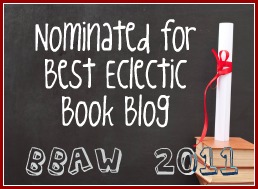Zetta Elliott, the talented author and blogger, cites an article on her blog noting that:
“…studies have consistently found that minority-race characters are underrepresented in fiction for children and young adults, and that existing portrayals of minority characters are often riddled with stereotypes or otherwise negative images.”
The source for this quote is riveting research reported in “The Journal of Research on Libraries and Young Adults” published in June, 2011. The data that captured my attention the most was from Table One:
As the authors point out, citing Hazel Rochman:
“Books can make a difference in dispelling prejudice and building community; not with role models and literal recipes, not with noble messages about the human family, but with enthralling stories that make us imagine the lives of others.”
Book bloggers can help make a difference by requesting books at stores and libraries that reflect more diversity, and by publicizing good books through reviews. All races, ethnicities, and genders can benefit from reading stories about each other and learning that really, we are all alike more than we are different.
If you prick us, do we not bleed?
if you tickle us, do we not laugh? if you poison
us, do we not die?”(The Merchant of Venice, Act 3, Scene I, William Shakespeare)”









Those statistics are pretty shocking. Looks like we need to work a little harder on the American Indian protagonists! I am to blame in some of these trends, I think, because I’ve never given any thought to the race of the protagonist. I choose books more on plot I guess. Lately though I have read some very culturally diverse books…one Indian, two African, one Caribbean, two Norwiegan (ha) and one Polish. All reviewed in July!
Yay I might have to post about the challenge as well, even if it is YA / MG only 🙂 Really is an interesting article / study.
God, that’s awful. Yeesh. I was reading an essay by bell hooks the other day about representations of minorities in television shows and films, and it made me very sad. But even for how terrible TV and film are about it, they seem still better than the YA fiction world (for instance). Or maybe I’m wrong…
Oh I love love love bell hooks! One of my favorite articles EVER is one by her on how she and all her family used to have hair day in the kitchen every Saturday morning. It’s from 1988 and is online – YAY! Link is here.
I’m asking me if it’s not worse in France for books and more for television show and film !
This challenge is a very good idea !
It is sad that diversity is such a dirty world in the world of literature, but I loved seeing this study and seeing how I can help. Thanks for sharing this with us, Jill!
I’ve been thinking about reviewing my own reading and making a chart like this one, just to see what the results would be. It’s summer vacation and I really do have the time for such a task.
I can’t speak for much more than my own classroom experience with 6th and 7th graders, but I suspect one reason why books about minorities are avoided is that they tend to be about being a minority. Kids sense the book will preach a message to them so they avoid it. They want fun books.
Lately, this has begun to change. Books like Bud, Not Buddy, and Paris Pan Takes the Dare have minority protagonists, but are not about race. They’re good books and fun reads. They want Hunger Games, They want Twilight. Give them that kind of reading and they won’t care what race the narrator is.
Wow, this is really disturbing on so many levels, especially when you consider the racial make-up of the US and how it is changing. I do not participate in formal reading challenges because somehow by signing up for them, I lose all interest in reading the books that qualify for them, but I do try to read more widely than I did before. I wonder, however, if publishers see the chart above and think “this is why white-washing is necessary,” rather than “diversifying our portfolio is key.”
I have Zetta Elliott very high on my wish list!
This challenge sounds fabulous, I may have to participate!
I will be adding diversity to my books as I can for the rest of this year. I do make a point of making sure that I have a great mix on my middle school library shelves but we still have a long ways to go.
You certainly helped Gage diversify his library!
Those are fascinating and disturbing percentages. I’ll admit that my own reading tends to follow those stats (unsurprising, I suppose, when the numbers are so extreme), but it has never appeared quite so starkly, perhaps because the realization was only ever a quiet voice in the back of my mind. Too quiet, I think.
The thing is, there are some excellent young adult books that deal with diversity, have non-white characters or even ambiguous characters, like the wonderful Make Lemonade series. Whale Talk is another great example.
Another problem, like CB James mentioned, is that oftentimes authors write books about race when having a minority character rather than just having… a book. Why does the automatic race choice for an ordinary story have to be white? Even the label “minority” is problematic, indicative of something different…
A lot, a lot to think about here.
Although things are better than they were back in the 60s when I was searching for minority protagonists for my fifth graders, those numbers are still very dismal. I’m joining the challenge too.